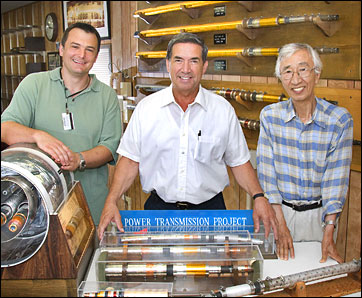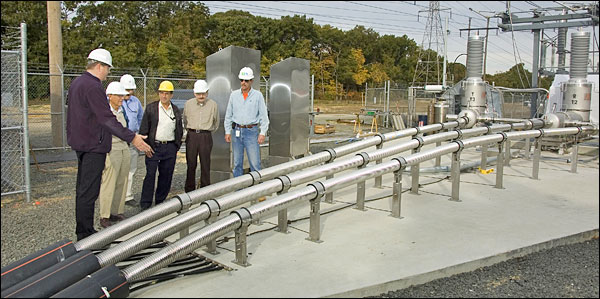LIPA Commissions New Superconducting Cable System, Involves Present and Past Brookhaven Lab Research
Early Lab Technology Enabled System Development
July 11, 2008

BNL superconducting cable researchers: (from left) Vyacheslav Solovyov, Department of Condensed Matter Physics & Materials Science (CMPMS), Tom Muller, Physics Department; and Masaki Suenega, CMPMS.
Current and former members of BNL joined officials of the Long Island Power Authority (LIPA) and American Superconductor Inc. on June 25 at the commissioning ceremony for the world's first high-temperature superconductor (HTS) power transmission cable system. The innovative 138 kilovolt (kV) system is capable of carrying 574 megawatts of power in a right-of-way of only four feet and is an important addition to Long Island's power supply.
Tom Muller, Ramesh Gupta, and Mike Harrison of BNL's Physics Department, Vyacheslav Solovyov of the Department of Condensed Matter Physics & Materials Science, and Masaki Suenaga, a retiree still active with this department, were among those who visited the site of the first such demonstration project to be integrated into an existing power grid. BNL research led to the technology's being demonstrated by the new cable system.
The system, which consists of three individual HTS power cable phases running in parallel, was energized on April 22, and is operating successfully in LIPA's Holbrook right-of-way. The cable system contains hair-thin, ribbon-shaped HTS wires that conduct 150 times the electricity of similar-sized copper wires. The present cables employed the so-called first generation HTS conductor composite wires, made of a bismuth-calcium-copper-oxygen/silver (Bi2Ca2Cu3O8/Ag) compound. This power density advantage enables transmission-voltage HTS cable to utilize far less wire and yet conduct up to five times more power in a smaller right of way than traditional copper-based cable.
DOE previously funded $27.5 million of the $58.5 million total project cost, which advances DOE's ongoing efforts through the Office of Electricity Delivery & Energy Reliability to modernize the nation's electric delivery infrastructure. At BNL now, Solovyov continues to research second generation HTS wires, made of yttrium, barium, copper and oxygen, (YBa2Cu3O7), under a Cooperative Research & Development Agreement (CRADA) between American Superconductor and DOE. This effort pursues enhanced properties and lower cost for the wires. (See CRADA sidebar, below)
Last November, Muller was part of another BNL group that made a journey to the LIPA substation at Holbrook. It was a trip he and others had been anticipating for more than 20 years. Along with Energy Sciences & Technology Department Chair Bill Horak and retirees Eric Forsyth and Rich Thomas, Muller inspected the system whose development they had fostered at the Lab in the 1970s and '80s.
A 100-meter BNL demonstration cable, installed near the site of the current Science Learning Center, was based on low-temperature superconductors, made of niobium-tin (Nb3Sn) and cooled with liquid helium. Although successful, the BNL project terminated in 1986 after four years of intensive testing, the same year the discovery of superconductors that could operate at temperatures above 77 Kelvins opened up the possibility of designing superconducting devices cooled with liquid nitrogen instead of helium. Superconducting cables conduct electricity with virtually no electrical losses, meaning that more of the power generated at power plants gets to customers. Conventional power grids typically lose 7 to 10 percent of power due to the inherent electrical resistance experienced with copper wires.
The Holbrook cable allowed LIPA to gain operating experience and train workers in the new technology. The existing overhead line was left in place with the superconducting cables connected in parallel; however, switches now allow the overhead lines to be disconnected, enabling the cables to carry the full load of about 500 megawatts. LIPA engineers are hoping the experience gained will lead to the installation of a circuit several miles long at the western end of Long Island where congestion will not permit more overhead lines.
Forsyth, who headed the engineers on the BNL project and, in 2007, was awarded the Herman Halperin Transmission & Distribution Prize by the Institute of Electrical & Electronic Engineers for his pioneering work on the technology, commented, "The Brookhaven demonstration more than two decades ago established the feasibility of this technology. The advent of high-temperature superconductors has simplified the engineering to some extent but the development of these materials to carry sufficient current for this kind of installation has been slow, which probably accounts for our 20-year wait.
"We were all impressed by the high quality of the work at Holbrook," continued Forsyth. "We wish LIPA every success in this pioneering effort by a commercial company.
DOE/American Superconductor, Inc. CRADA Will Produce Second Generation Wire
The new LIPA transmission system uses the first generation (Bi2Ca2Cu3O8/Ag composite) of the high-temperature superconductor (HTS) wire technology first studied at BNL. Vyacheslav Solovyov of the Department of Condensed Matter Physics & Materials Science is working on the technology's second generation (YBa2Cu3O7/Cu composite). Under a Cooperative Research & Development Agreement (CRADA) between DOE and American Superconductor Inc., Solovyov is studying the factors necessary for wider commercialization of HTS based on yttrium barium copper oxide (YBCO)-coated conductor technology for electric power applications.

The group inspects the pipes containing the HTS cables, capable of carrying 574 megawatts of power in a four-foot right of way.
Both BNL and American Superconductor are studying the growth of YBa2Cu3O7 films on a cerium oxide (CeO2) buffer layer, and studies have shown that the properties of a CeO2 buffer layer are critical to the superconducting performance of those films. The CRADA focuses on developing a fundamental understanding of the relationship between the surface morphology and chemistry of the buffer layer and the nuclei density of YBa2Cu3O7 in the thick and thin films.
"We're trying to understand the properties of the wire and how to improve it," Solovyov said. "The current technology can run at high temperature - about 77 Kelvins - reducing the operational cost, but the cost of the wire is still too high for widespread applications. The demonstration project is an important milestone, but we will make it better and cheaper."
2008-778 | INT/EXT | Newsroom









